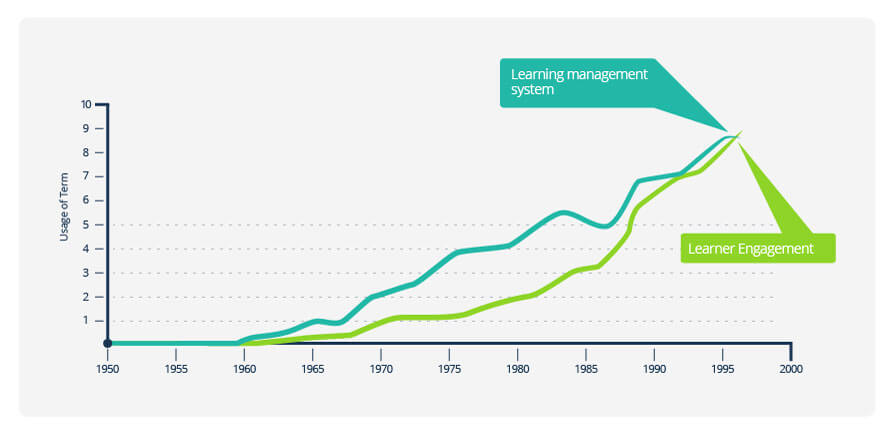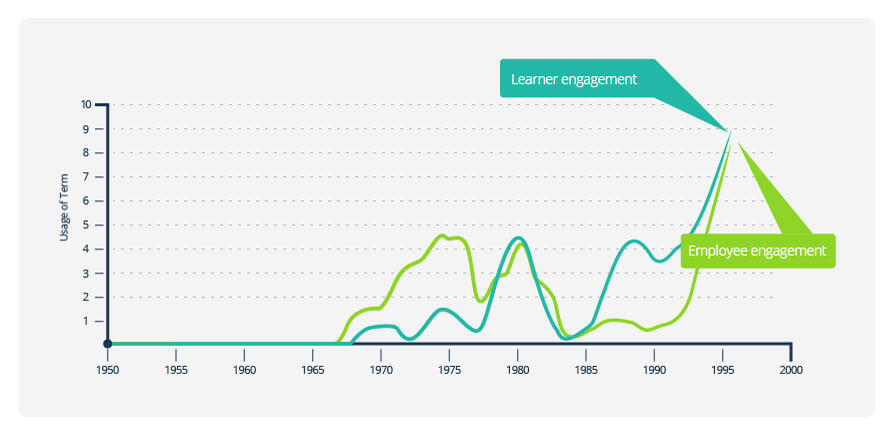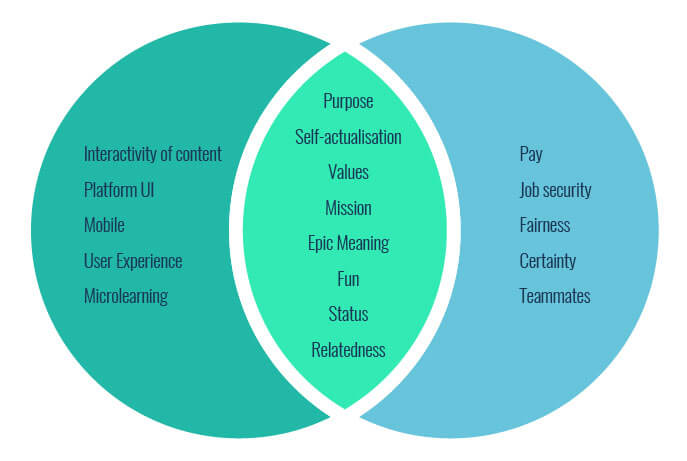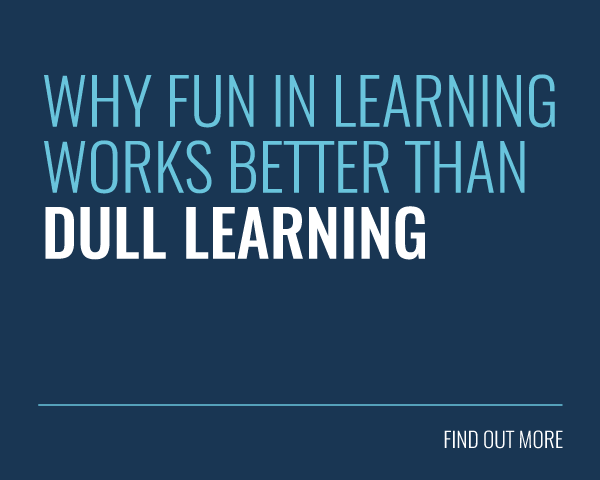
Everyone’s trying to engage someone these days. Whether it’s young lovers proffering a ring, armies clashing on the battlefield or public speakers grabbing their audience’s attention.
There are lots of different types of engagement. Thankfully, most people only have to contend with one type of engagement at any one time.
But it’s not so easy for HR and L&D professionals.
Learning professionals have to deal with learner engagement and employee engagement. These types of engagement are frustratingly similar, but still different enough to warrant a clear distinction. As if life wasn’t confusing enough!
From the outside looking in, the difference might seem unimportant. So why worry? Well, like all things which are similar-but-different, it might not be important to everyone, but to a select group, it is vital to get it right. You wouldn’t want to present a Marmite lover with Bovril. And you wouldn’t want to build an office from cement instead of concrete.
In this article, we’re going to unmuddle things for you. We’ll start by breaking down each type of engagement and exploring their history. We’ll end by looking in more detail at how they overlap and how you, as a learning professional, can forge a path towards both learner engagement and employee engagement.
Learner Engagement
Learner engagement is important for L&D professionals. It refers to how much attention your audience is giving your online learning content.
It’s an idea L&D borrowed from the world of marketing. Marketers think about engagement in terms of attention. After all, they are very literally a great big bunch of attention seekers.
Ever since the rise of social media, ‘engagement’ has become a common term. People now use it to describe how much attention they have managed to capture from their audience. They view things like retweets, likes and comments as ‘engagement’ with a person or brand.
Learner engagement is a specific type of audience engagement. Your audience is your learners and their engagement is how much of their attention your online learning has managed to capture.
The History of Learner Engagement

This graph from Google Ngram Viewer demonstrates how much a term is used over time. It scours books and articles to show the lifecycle of an idea.
Here, you can see ‘learner engagement’ in green and ‘learning management system’ in turquoise. The two terms have followed a similar path, with ‘learner engagement’ tracking ‘learning management system’ a few years behind.
It’s no coincidence that the rise of learning management systems preceded the need for learner engagement. There are two key reasons for this:
- Online learning platforms made it easy for L&D professionals to measure and track how much learners were engaging with their content. Reporting suites meant they could ascertain content completion rates, logins, drop out rates, and more, for the very first time.
- Learning management systems were notoriously boring for the first few decades of their existence. Learners would log into their online learning platform, their eyes would glaze over and they’d never come back. Little wonder the goal of engaging learners soon gained traction.
Employee Engagement
Employee engagement has nothing to do with engagement as framed within marketing. It’s less to do with capturing the attention of your employees, and more to do with capturing their hearts and minds.
Employee engagement is about inspiring your people to care about what they’re doing.
This can be on a small scale so that employees are engaged with a specific task, or on a bigger scale so that your employees are engaged with their job as a whole. And it doesn’t stop there. You can talk about the engagement of teams or even whole companies.
When an employee is engaged, they bring the whole of themselves to their work. This means that you get the very best of their physical, mental, cognitive and emotional abilities.
The History of Employee Engagement

This graph shows the popularity of the terms learner engagement and employee engagement over fifty years. Whilst both have peaked and troughed since the 60s, they’ve both exploded into significance since the 90s.
Employee engagement has been rigorously studied since the 70s. It’s a massive and important topic within the business world. Over 1,000 papers were published on employee engagement in the first six months of 2020 alone, and there are over 1.2 million results for the topic on Google Scholar. That’s a lot of research.
In 1990 ‘From People to Profits, the HR link to the service-profit chain’ was published. It brought employee engagement into boardrooms across the globe because it demonstrated a direct link between engaged employees, satisfied customers and increased revenue.
This research was then followed up by plenty more. But the defining moment for employee engagement was Gallup’s 2013 employee engagement survey. It’s finding’s stunned business leaders: only 13% of employees across America were engaged.
Suddenly, engagement was an urgent priority. And it remains that way to this day.
How Do They Overlap?
The two types of engagement are clearly quite different. But in what ways do they overlap?
This is important to understand. Especially as those who are invested in one of the two are likely to have a vested interest in the other as well. And given that’s the case, we have some good news. Many of the proven strategies to increase learner engagement will increase employee engagement as well, and vice versa.
The Venn Diagram below demonstrates the differences and similarities between the two engagements.

On the left are the elements of learner engagement which don’t directly impact employee engagement, whilst on the right are the elements of employee engagement which don’t directly impact learner engagement.
But in the centre of the diagram, you’ll see there are a lot of factors which contribute to both learner engagement and employee engagement.
This raises the question, is there a clear relationship between learner engagement and employee engagement?
The Link Between Employee Engagement and Learner Engagement
Engaged employees are much easier to motivate to complete training. If an employee cares about your business and your mission, and if they understand the role they play, then it will be much easier for them to see the value your training offers them.
It’s also true that employees who are worried about the security of their role or feel unfairly treated will be much less engaged with their job. In turn, they will be reluctant workplace learners.
On the other side, team members who are engaged with their learning will become more engaged as employees. Learning can be fun, it can spark curiosity and it also releases feel-good chemicals in the brain. This drives further engagement throughout your learners and helps them to derive more enjoyment from their job.
But even more importantly, learning and development drives a greater sense of self-actualisation. That means that as your employees learn, they have a sense of growth and of becoming who they want to be.
You can also use your learning content to reinforce your learners’ sense of epic meaning. This means they will have a better understanding of your organisation’s purpose and the role they play in it.
Three Ways Training Drives Employee Engagement
1. Training Helps You Shape Your Organisation’s Culture
The training you choose to deliver has a knock-on impact on your organisation as a whole. It’s the perfect way for you to let your learners understand what behaviours will help them fit into the business. Ultimately, this will help them feel like they belong to your organisation’s community, which is essential to engagement.
2. Training Shows You Care
60% of millennials say that learning and growing at work is essential. This means employers need to invest in staff training to help them grow. This is particularly important in a world where the average employee is increasingly sceptical about business motives. You now need to prove you care, not just say that you do. Training is one of the very best ways you can do that, as you’re investing in people as individuals.
3. People Like Being Good at What They Do
Self Determination Theory helps us to understand the nature of motivation and engagement. This model emphasises the importance of competence in driving certain behaviour throughout a group of people.
Three Reasons Engaged Employees Make Engaged Learners
1: 68% of Employees Work Harder When They Feel Valued.
Feeling valued is an important part of employee engagement. It’s no surprise that engaged employees would work harder. But remember, many employees consider workplace training a key part of their role. This means that 68% of staff would take their online learning more seriously if they felt more valued.
2: Engaged Employees will be Learning Ambassadors
Employees who are engaged are generally much more invested in organisational activities, whereas disengaged employees typically require a lot more persuasion. You’ll even find your engaged employees proactively encouraging their colleagues to complete training. They’re like your very own organisational influencers!
3: Engaged Employees Go The Extra Mile
Ordinary employees typically do what is required or expected of them, whereas an engaged employee is marked out by their enthusiasm and energy. This means an unengaged employee will do required training, whilst an engaged employee might explore your learning library and proactively seek opportunities to grow and improve.
Final Word
There you have it. Learner engagement and employee engagement are incredibly similar. But, there are key differences between them which are essential for all L&D and HR professionals to understand.
Once you’ve understood the differences, the overlap becomes clear. You can use your knowledge of their similarities to help achieve engagement goals. Neither learner nor employee engagement exists in a vacuum. Improve one and there is a very good chance you’ll improve the other! Exploring our 10 top tips for maximising employee engagement is a great place to start.
If you want to learn more about either employee or learner engagement, Growth Engineering are the unequivocal experts. Why not check out our guide on the science of engagement? It will help you understand what’s going on in the brain of engaged learners! Just click here to grab your copy!








